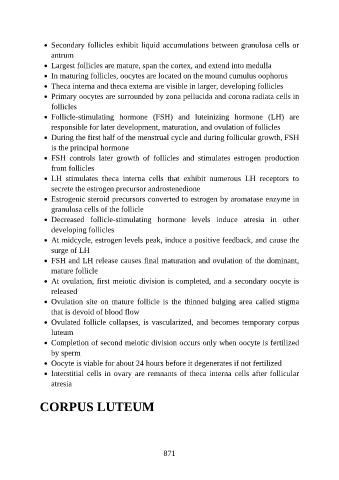Page 872 - Atlas of Histology with Functional Correlations
P. 872
Secondary follicles exhibit liquid accumulations between granulosa cells or
antrum
Largest follicles are mature, span the cortex, and extend into medulla
In maturing follicles, oocytes are located on the mound cumulus oophorus
Theca interna and theca externa are visible in larger, developing follicles
Primary oocytes are surrounded by zona pellucida and corona radiata cells in
follicles
Follicle-stimulating hormone (FSH) and luteinizing hormone (LH) are
responsible for later development, maturation, and ovulation of follicles
During the first half of the menstrual cycle and during follicular growth, FSH
is the principal hormone
FSH controls later growth of follicles and stimulates estrogen production
from follicles
LH stimulates theca interna cells that exhibit numerous LH receptors to
secrete the estrogen precursor androstenedione
Estrogenic steroid precursors converted to estrogen by aromatase enzyme in
granulosa cells of the follicle
Decreased follicle-stimulating hormone levels induce atresia in other
developing follicles
At midcycle, estrogen levels peak, induce a positive feedback, and cause the
surge of LH
FSH and LH release causes final maturation and ovulation of the dominant,
mature follicle
At ovulation, first meiotic division is completed, and a secondary oocyte is
released
Ovulation site on mature follicle is the thinned bulging area called stigma
that is devoid of blood flow
Ovulated follicle collapses, is vascularized, and becomes temporary corpus
luteum
Completion of second meiotic division occurs only when oocyte is fertilized
by sperm
Oocyte is viable for about 24 hours before it degenerates if not fertilized
Interstitial cells in ovary are remnants of theca interna cells after follicular
atresia
CORPUS LUTEUM
871

